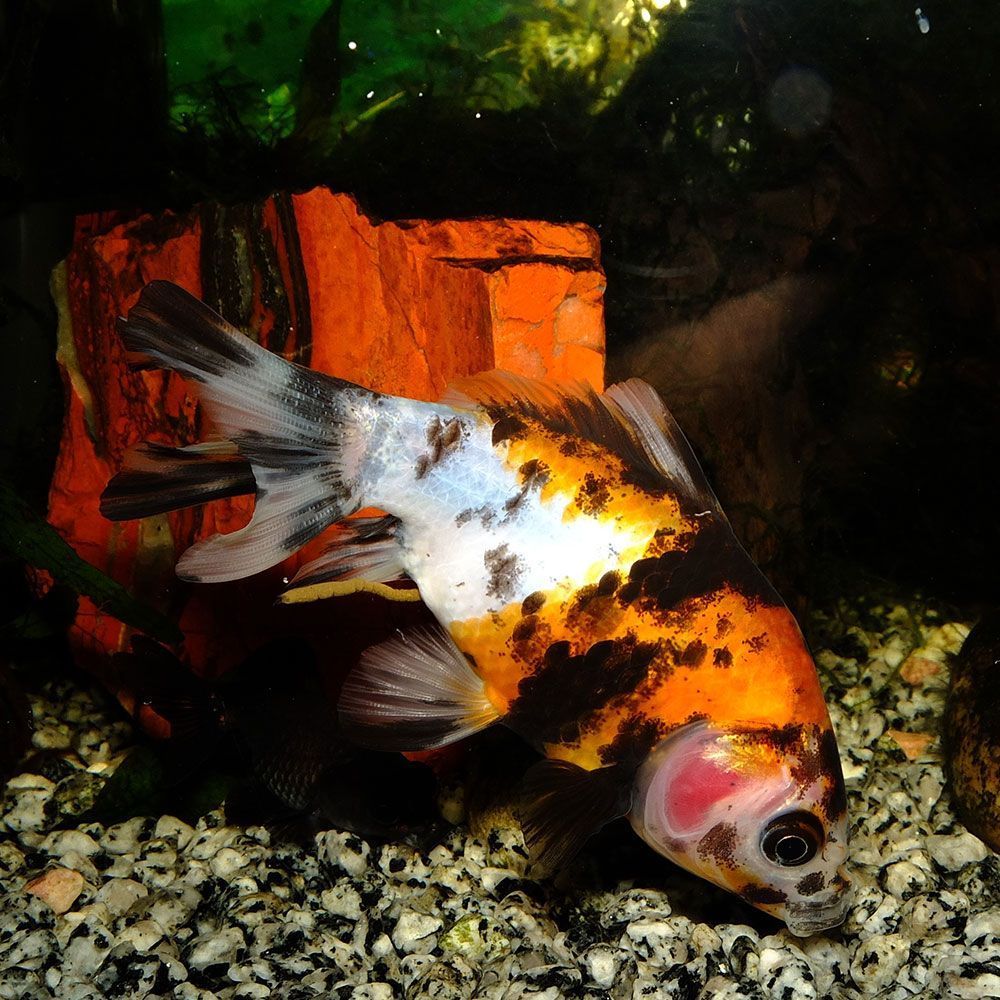If you want to make your freshwater aquarium even more attractive with some mesmerizing, friendly fish, goldfish are a great choice.
Raising goldfish is a rewarding and relaxing experience. These intelligent and delightful pets are known to live for a long time, making them excellent companions.
Interested in getting a goldfish? Let’s learn about a wide range of them here.
What is the Background of Goldfish?
Goldfish, scientifically known as Carassius auratus, are a popular choice among most freshwater aquarists.
Originating from China, these relatively small members of the carp family were selectively bred for color over a millennium ago, resulting in the development of more than 200 distinct breeds.
Goldfish can be broadly categorized into two main types based on their tail and fin configurations.
- Single-tailed (common types): These feature a single streamlined tail fin and are known for their active swimming. They are ideal for larger aquatic environments such as ponds.
- Double-tailed (fancy types): They possess two distinct caudal fins, an ornate appearance, and a graceful, slower swimming style. They are popular choices for indoor aquariums.
Note: This article will focus exclusively on common and rare goldfish species for your aquarium. Fancy varieties are discussed in a separate article.
What are the types of goldfish?
Though the most prevalent color of goldfish is orange, they come in a wide range of colors.
Goldfish are known for their intelligence and sociable nature,
Though there are vast types of goldfish, you need to choose a variety that suits your lifestyle and fish-keeping abilities.
C’mon, let’s dive into the most popular common breeds of goldfish here!
1. Common Goldfish
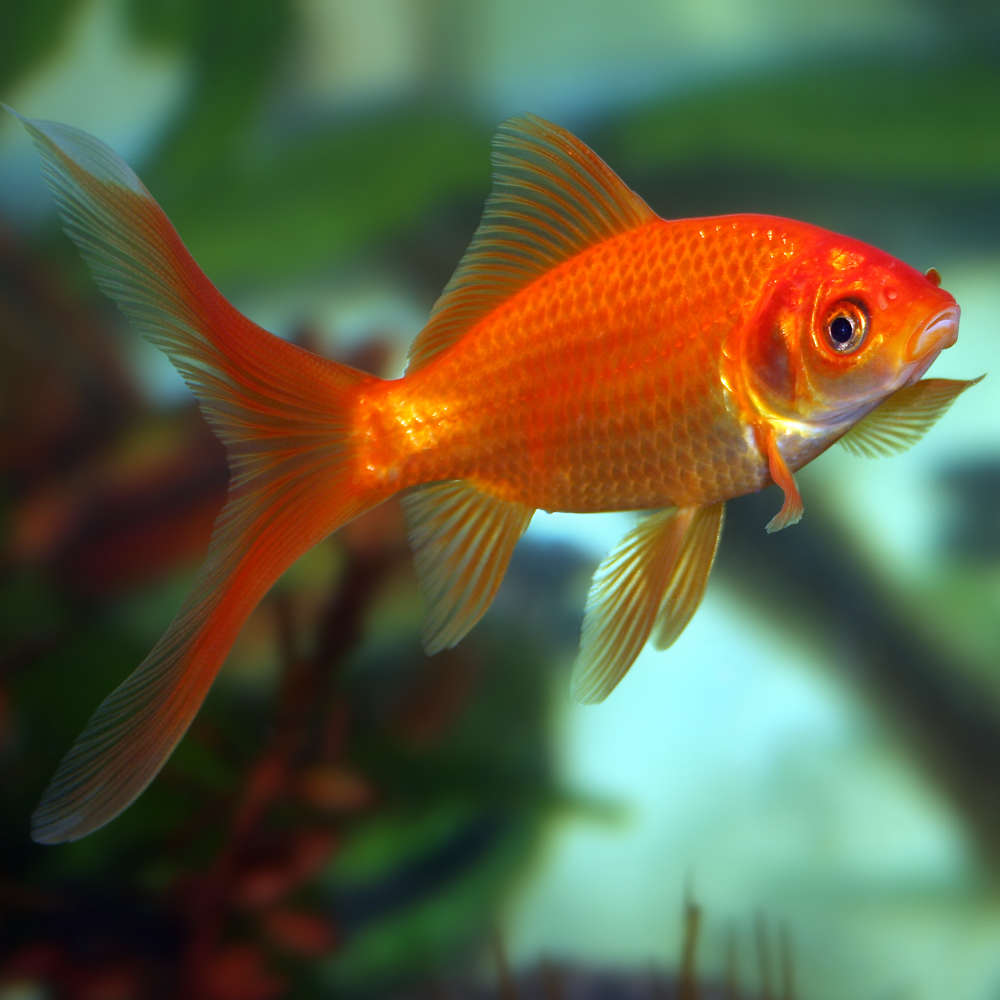
- Average Size: Up to 15 cm (6 in) in captivity, max: 47.4 cm (18.7 in)
- Average Lifespan: Up to 10-20 years, max: 43 years
- Colors: Red, orange, red-white, white-black, yellow-white, blue, gray-brown, olive green, yellow, white, and black
- Minimum Tank Size: 30 gallons for 1, 75 gallons for an adult pair
The common goldfish originated from wild carp in ancient China. It evolved into vibrant ornamental fish through genetic mutations. Buddhist monks noticed the species first and kept it as pets.
Besides bright metallic orange, you can also find the fish in red, red and white, white and black, yellow and white, blue, gray and brown, olive green, yellow, white, and black.
It naturally changes colors over time, especially in the first year of life.
The fish also has an elongated, flat body with a short, wide head, a forked tail fin, and a belly stripe. The fins are short and upright, including a slightly curved dorsal fin.
It has small, regenerating flat teeth called pharyngeal teeth at the back of the mouth, visible as small white bumps when the mouth is open.
This fish is highly intelligent and socially interactive. It recognizes individual humans, displays positive reactions to owners, and can even be trained to perform tricks like swimming through hoops or dunking a miniature basketball. Its memory lasts at least three months.
2. Comet Goldfish

- Other Name: Comet-tailed goldfish
- Average Size: Up to 10-30 cm (4-12 in)
- Average Lifespan: Up to 5-14 years, Max: Up to 20 years
- Colors: Yellow, orange, red, white, red-white, reddish-orange, brown, yellow, black
- Minimum Tank Size: 75 gallons for one, 50 gallons for each extra fish
In the 1880s, Hugo Mulertt, a U.S. government worker, developed the comet-tailed goldfish through selective breeding from crucian carp and a mutated ryukin.
The lively fish quickly gained popularity, becoming staples in pet stores, carnival prizes, and even angler bait due to its ease of breeding. Mulertt introduced it to the fish-keeping market.
Comet goldfish have a thin, elongated, flat body, gradually tapering from the back to the base of the tail fin. It also has a wide and short head and a long and deeply forked tail fin.
It’s available in a range of colors, including yellow, orange, red, white, red and white, reddish-orange, brown, yellow, and black, often featuring red accents on the tail, dorsal fins, and sometimes pelvic fins.
Some feature colorful spots and scales that vary between metallic and nacreous, giving a pearlescent look.
The fish has two unique varieties,
- Sarasa: It has long flowing fins and red and white coloration, resembling the patterns of koi carp or kohaku. Although it originated in China, the term sarasa has Japanese origins.
- Tancho: Tancho has a silver-colored body with fins and a single red patch on the head.
The fish is known for its playful and active behavior. Unlike other goldfish breeds, comets love to swim around the tank. It’s also the perfect choice for outdoor ponds where it can race alongside koi companions.
3. Shubunkin Goldfish
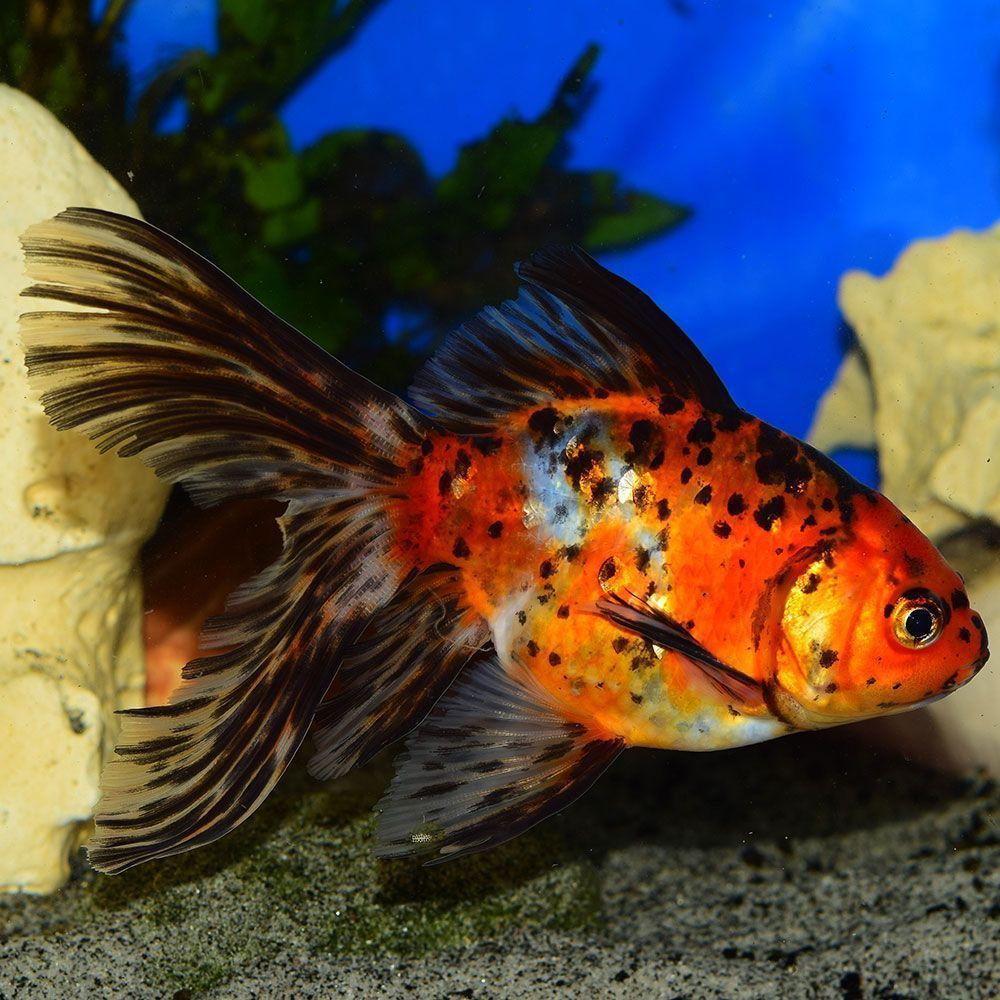
- Other Name: Calico goldfish
- Average Size: Up to 30-35 cm (12-14 in)
- Average Lifespan: Up to 15 years, Max: 30 years
- Colors: Calico patches of red, yellow, orange, white, blue, gray, and black
- Minimum Tank Size: 75 gallons for one
In 1892, Japanese breeder Yoshigoro Akiyama I created this goldfish by cross-breeding calico telescope, common goldfish, and single-tail Wakin. Named in 1900 for its colors resembling a kimono, it was revealed to the public in 1902.
Shubunkin goldfish have a streamlined body, even and well-developed fins, long, flowing tails, and mosaic nacreous scales.
There are overlapping patches of red, yellow, orange, white, gray, and black with speckles extending to fins.
There’s also a rare blue shubunkin that is costlier. Initially, blue wasn’t part of the calico category. It comes from precise breeding.
Crossing metallic bronze with matte-scaled pink goldfish can create unique blue colors, but they often come out as gray.
Some variants are:
- American Shubunkins: It has a slimmer body, deeply forked tail fins, and longer overall fins.
- London Shubunkins: It has a stout body and short, rounded fins.
- Bristol Shubunkins: The rarest of the Shubunkin varieties. It features a broad body with an exaggerated heart-shaped tail.
Shubunkin goldfish, often found in regular pet stores and home centers, is not only visually appealing with colorful fins and blue hues but also incredibly easy to care for.
It’s an excellent companion for other friendly fish, hardy, adaptable, and instantly adds life to any fish tank or pond. It’s an ideal choice for beginners.
4. Sarasa Goldfish

- Other Common Names: Sarasa comet, sarasa commons, painted goldfish
- Average Size: Up to 5-10 cm (2-4 in) in tanks, 20-35 cm (8-14 in) in ponds
- Average Lifespan: Typically 10-15 years, Max: more than 20 years
- Color: Splotches of red, gold and white
- Minimum Tank Size: At least 30 gallons, thrives best in 180 gallons pond
Sarasa goldfish, originally found in China, is now available worldwide. It’s known for its Kohaku patterns, as in koi and butterfly koi.
The sleek-bodied fish has single, straight tail fins and is available in red, gold, and white.
Each fish has a color pattern that is unique to it. There are two tail shapes: long and flowing like a “V” or short and round.
It’s among the most popular goldfish types, ideal for beginners and experienced fishkeepers. It coexists with other fish in spacious, well-circulated tanks or ponds. It requires a high-quality, well-tailored diet to prevent malnutrition and disease.
Sarasa in Japanese means calico, describing the mottled patterns of this fish. It’s confused for ornamental carp, but it doesn’t have the mouth whiskers, scale base markings, or size of ornamental carp.
The rare goldfish varieties are generally exclusive to Asia and are hardly available in significant quantities, making information about them quite scarce.
They are rare due to a number of reasons like the following:
- Highly expensive
- Affordable but have high international shipping costs
- Not bred intentionally
- Can’t stand long-distance shipping
- Demanding care
5. Tamasaba Goldfish

- Other Common Names: Mackerel tail goldfish, Yamagata goldfish, Yamagata kingyo
- Average Size: Up to 25 cm (10 in) in a tank, more in a pond
- Average Lifespan: Up to 10 years in an aquarium, more in a pond with optimum conditions
- Color: Red and white
- Minimum Tank Size: 125 gallons for 10 fish.
The tamasaba goldfish originates from Japan’s Yamagata prefecture and is the result of crossing a single-tailed syounai with a double-tailed ryukin.
It has a round body, arched back, a single anal and caudal fin, and long, flowing tails like mackerels (hence, the name). It features striking red and white skin patterns.
The beginner-friendly and hardy fish thrives in both aquariums and outdoor ponds.
There are three variants of tamasaba goldfish.
- Tamanishiki: It features transparent scales with a striking red contrast against a white backdrop.
- Fuku Daruma: It has a round, hand-like shape. Created over three decades, it has more sub-variants like short, medium, and long-tailed versions, as well as those with transparent scales.
- Calico: It stands out for its unique calico body color, but it is relatively rare with limited breeding.
It’s often not found in regular pet stores but can be obtained from breeders in Japan and can be expensive: £120 ($150) per fish. Despite the ease of care, long-distance transporting stresses and weakens it, leaving it vulnerable to diseases.
6. Sabao Goldfish
- Average Size: Up to 25 cm (10 in) in a tank, more in a pond
- Average Lifespan: Up to 15 years
- Color: Red and white
- Minimum Tank Size: 20 gallons for one, 130 gallons for 10 to 15 fish.
The sabao goldfish originated in Japan through a cross-breeding of syounai with ryukin. This yielded two fry types:
- Sabao: which is rounder like syounai
- Tamasaba: resembling ryukin.
The round-bodied fish shares similarities with comet goldfish but lacks the hump seen in tamasaba. It has shorter caudal peduncles, long tails, and elongated fins. It’s an agile swimmer displaying its lively tail fins.
This fish is exceptionally rare, primarily due to the limited breeding of its parent, the syounai goldfish.
Stores may mislabel it as tamasaba, so it’s important to distinguish it correctly.
Sabao goldfish are bright and playful around peaceful tankmates. But it’s not the easiest to find due to its rarity and price. It thrives in colder water temperatures, inherited from the syounai, making it suitable for outdoor ponds.
7. Izumo Nankin Goldfish
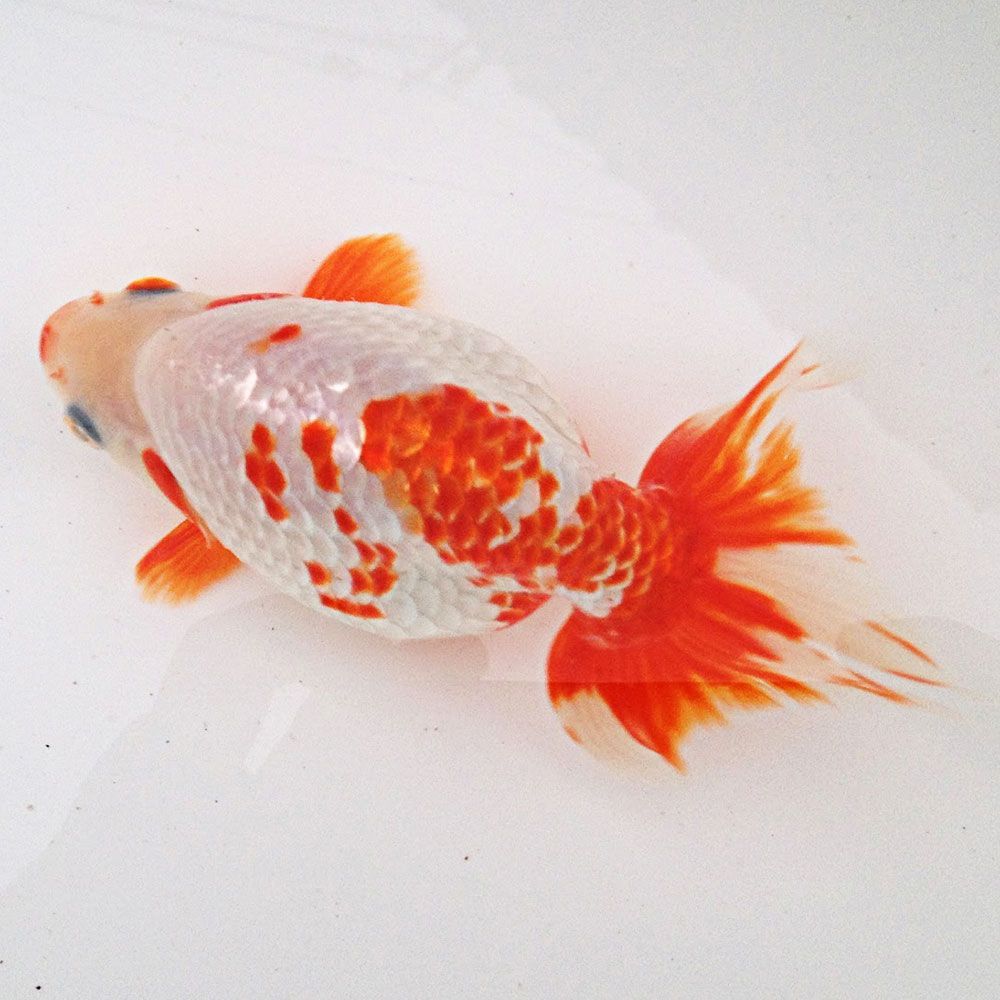
- Other Name: Nankin
- Average Size: Up to 15-23 cm (6-9 in)
- Average Lifespan: Up to 10-15 years
- Colors: White-red, gold or orange
- Minimum Tank Size: 30 gallons for one fish; add 10 gallons per extra fish
Originating sometime between 1748 and 1750 in Japan’s Izumo district, the nankin goldfish earned protected status in Shimane Prefecture in 1982.
The origin of its name, possibly linked to Nankin in China or imported “Nankin” goods from that era, remains unclear.
It’s believed to be an improved breed of the Marco, a ranchu variety.
The izumo nankin is typically orange and white, with an ideal combination of both colors. Some can be entirely white or entirely orange. Owners may use plum vinegar to remove color pigment from orange areas, enhancing the desired orange and white mix.
The body forms a triangular shape when viewed from above, and the tail shows partial fusion. It resembles a ryukin goldfish without a dorsal fin and has a twin tail like the ranchu goldfish.
It has a small head without a lump, long, narrow eyes, and long, extended fins.
This beautiful tranquil goldfish is a rarity outside Japan. The cost of shipping it abroad contributes to its rarity. But in Japan, it is relatively common and inexpensive (around $10-20), with dedicated fancier associations and clubs.
8. Nymph Goldfish
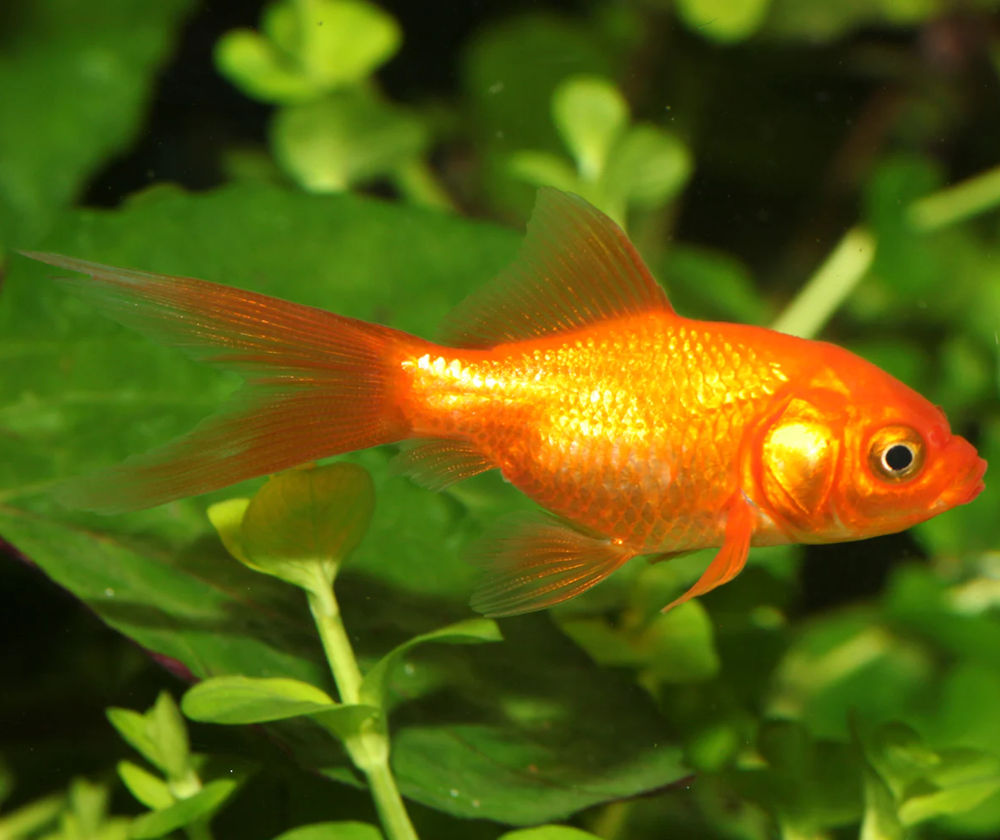
- Average Size: Up to 20-30 cm (8-12 in), Pond varieties up to 50 cm (20 in)
- Average Lifespan: Up to 5-8 years, Max: Up to 10 to 15 years
- Colors: Various combinations of red, white, orange, black, yellow, and mixed patches of two or more colors.
- Minimum Tank Size: 20 gallons for one in a rectangular tank with more horizontal swim space. Additional 5 to 10 gallons for extra fish.
The nymph goldfish has been around for a decade and is closely related to the fantail and veiltail breeds.
It possesses a single tail and anal fin, stemming from recessive genes inherited from its parentage.
Unlike fantails and veiltails, the nymph is an agile swimmer and is considered one of the faster and more versatile goldfish strains, second only to comets and commons.
Its exact origin remains unclear, but it’s believed to have Western roots, possibly originating in the USA.
The round-bodied fish resembles a fantail, coupled with a straight tail similar to a comet. It comes in various colors, including red, white, orange, black, yellow, and calico, with scales that display a range of warm hues.
It has a high dorsal fin, well-developed pectoral and pelvic fins, and normal or telescopic eyes.
The fish is rare because it’s a result of recessive genes and isn’t intentionally bred. It’s usually priced between $5 and $35.
Beginners find it appealing due to its resilience in varying water conditions and adaptability to different temperatures. It’s also quite durable when provided with suitable water quality and diet, contrary to misconceptions.
9. Siamese Doll Goldfish
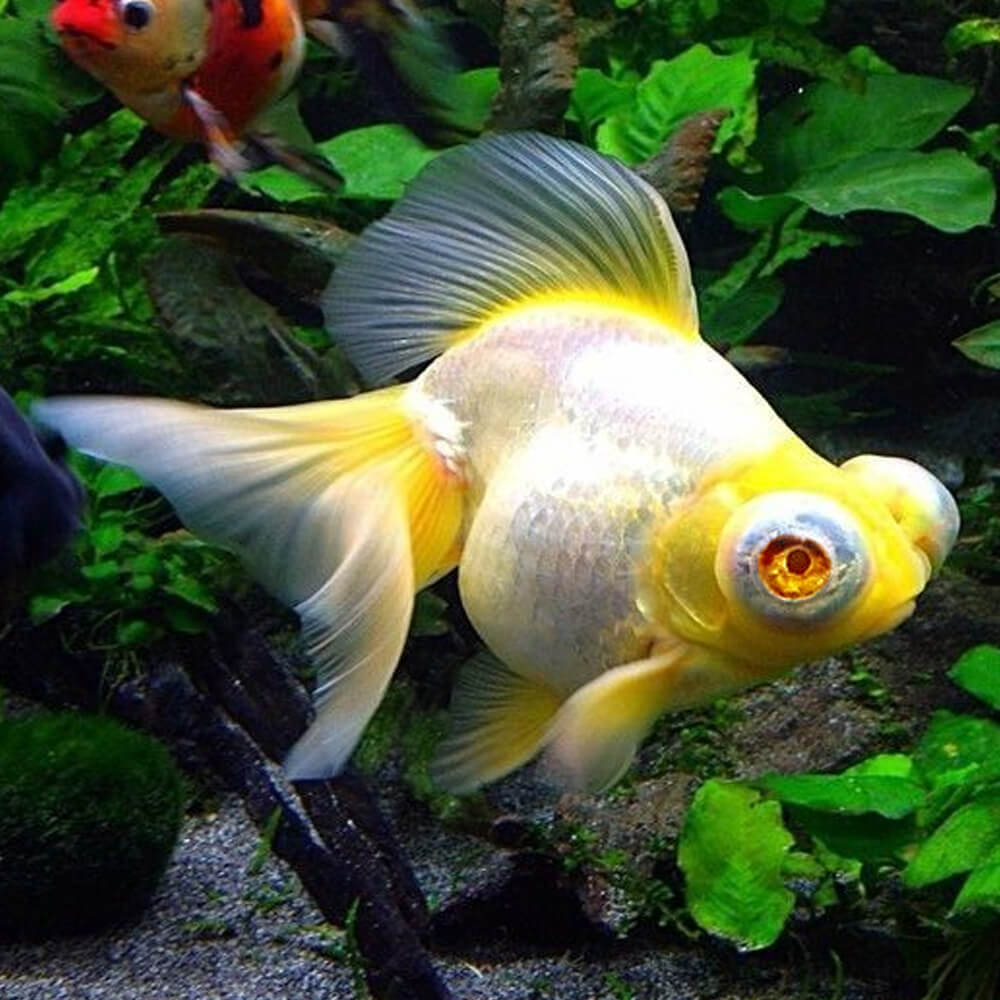
- Other Name: Albino telescope
- Average Size: Up to 12 cm (5 in)
- Average Lifespan: Up to 10-15 years
- Color: Pale yellow body with red or orange eyes
- Minimum Tank Size: 10 gallons
The Siamese doll goldfish, a rare and captivating variety, is the result of dedicated fishkeepers’ cross-breeding efforts.
It features a deep, compact, round, pale yellow body with striking red or orange telescopic eyes protruding from the sides of its broad head.
It has well-developed fins, including a split, veil-like caudal fin and a high dorsal fin.
This is one of the world’s tiniest goldfish varieties, making it a rare and prized species. It requires less tank space than common goldfish.
Due to its unique eye shape and slower swimming pace, it demands special care. You must also keep it with non-aggressive tank mates, or it will feel threatened.
10. Hama Nishiki Goldfish
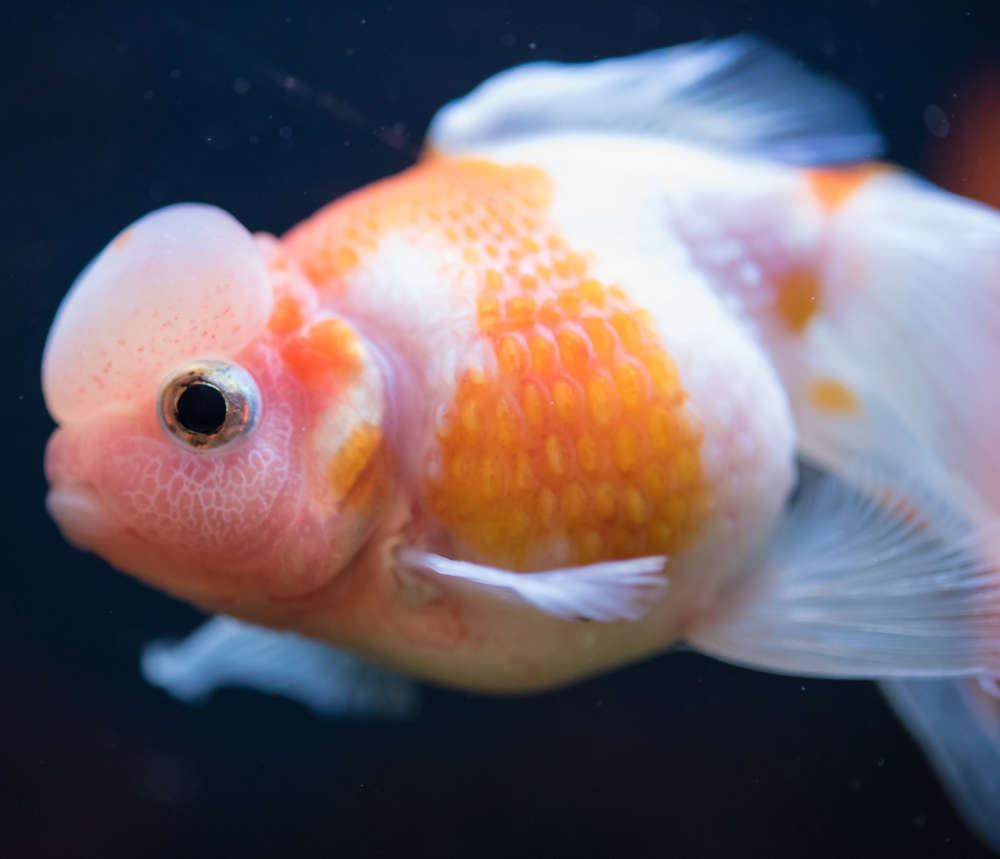
- Other Common Names: Crown pearl goldfish, crown pearlscale, high head pearlscale
- Average Size: Up to 20 cm (8 in)
- Average Lifespan: Up to 5-10 years
- Colors: White, red, blue, black, chocolate brown or calico.
- Minimum Tank Size: 30 gallons for one, additional 10 gallons per extra fish
The Shimizu Goldfish store (Hamamatsu, Shizuoka Prefecture) developed a distinctive lump on pearlscale goldfish’s head after importing the fish from Hong Kong.
This selection and breeding process started in the late 1960s and led to the creation of hama nishiki variants. They introduced the fish to the public in 1978.
The name hama nishiki incorporates hama from Hamamatsu (the city where Shimizu Goldfish store was situated) and nishiki: crown pearl (Japanese).
It stands out with its bubble-like head lumps, which are solid, not filled with liquid like the bubble eye. The round body resembles a golf ball, adorned with thick, domed pearl-like scales just like the pearlscale goldfish.
The fish come in various fin lengths and solid colors, including white, red, blue, or black, with some specimens showcasing calico and chocolate brown varieties.
It has unique nacreous scales, resulting from genetic mutations that cause calcium carbonate deposits. The scales are neatly arranged, giving a shiny, luminescent, and bead-like appearance, which inspired its name.
While Japan primarily has the crown pearl and the pearl goldfish with pearl scales, China boasts a variety of goldfish breeds featuring these unique scales.
It’s challenging to acquire hama nishiki due to its limited distribution and demanding care owing to frail characteristics.
11. Egg-fish Goldfish
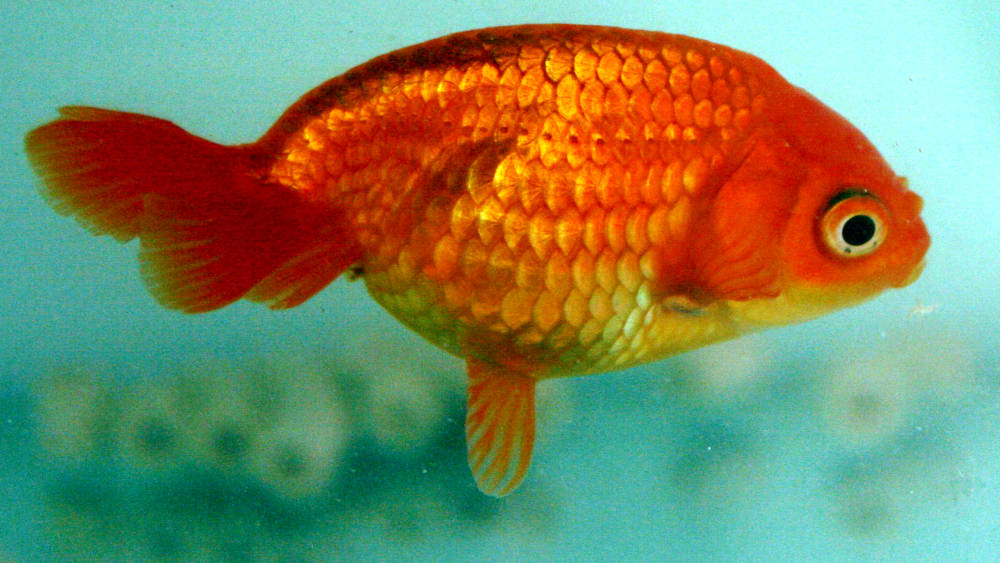
- Average Size: Up to 10-18 cm (4-7 in)
- Average Lifespan: Up to 8-12 years
- Colors: Orange, white, red, black, metallic, calico, and more
- Minimum Tank Size: 30 gallons for one, additional 10 gallons per extra fish
During the Ming Dynasty in China (1368-1644), goldfish were raised indoors in bowls as pets.
This unique environment led to the selection of genetic mutations that couldn’t stand the outdoor pond environment.
As a result, distinct traits evolved, leading to the development of the eggfish goldfish. This served as the precursor to various other goldfish varieties, including the celestial, lionhead, pompom, and bubble eye.
Eggfish have a distinct, deep, egg-shaped body and no dorsal fin, resembling ranchu but without the hood or wen. It is also smaller than a ranchu goldfish.
The fish resembles the pompon without nasal growth and a celestial or bubble eye without eye modifications.
It comes in all shades of color like black, orange, white, red, and mixes of two or more colors like silver-white, red-white variegated, and metallic.
The common variants are:
- Phoenix: It has a long tail and lacks a dorsal fin, named after the legendary phoenix.
- Pearlscale: It has domed scales similar to the pearlscale.
- Calico: It has a shorter and smaller head compared to the body, a fanned tail, mottled black, orange, and metallic white shaded body.
Eggfish goldfish are relatively rare in the West because they are maintained as distinct varieties in Hong Kong and China. With their unique appearance, they require delicate care and are best suited for indoor living, sharing similar care requirements with other fancy goldfish breeds.
A word from FishInAquarium
Whether you’re drawn to the captivating yet simple common breeds or the uniqueness of rare breeds of goldfish, there’s something for everyone!
Other than a few, most of these smart goldfish breeds entertain you for years to come with minimal care.
They also come in a variety of prices depending on your budget. So, if you’re interested, now is the time to make your pick from the diverse options!
We hope you’ve enjoyed learning about the fascinating world of goldfish varieties in this article. If you found it useful, consider sharing it with fellow enthusiasts.
If you have any questions or need support on goldfish care, please feel free to reach out to us. Your goldfish-keeping journey can be an enriching and joyful one, and we’re here to help you every step of the way.

